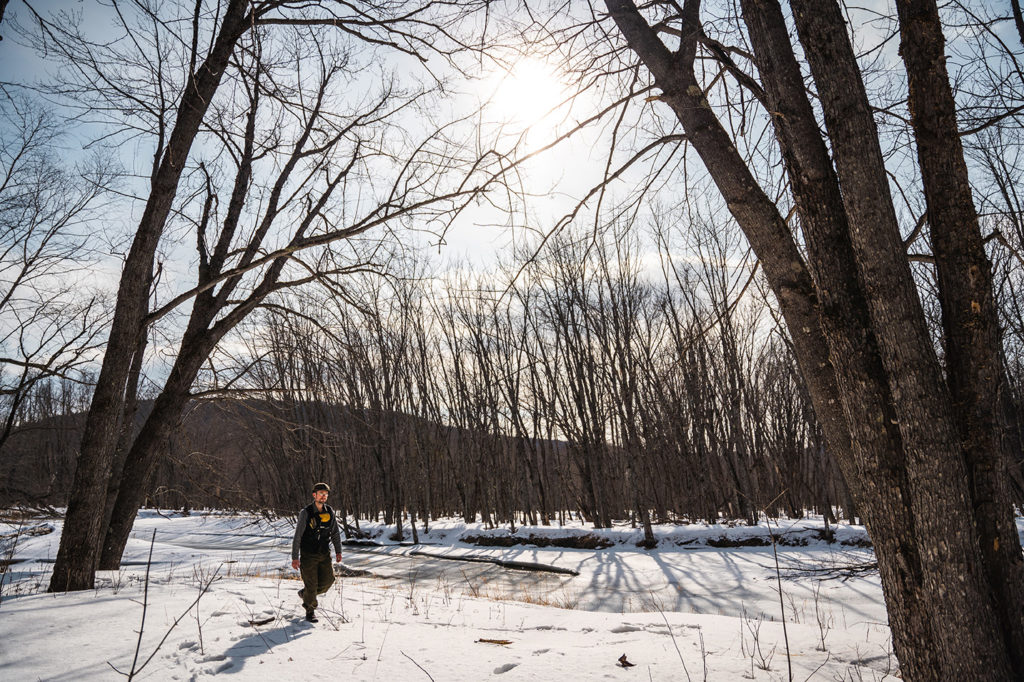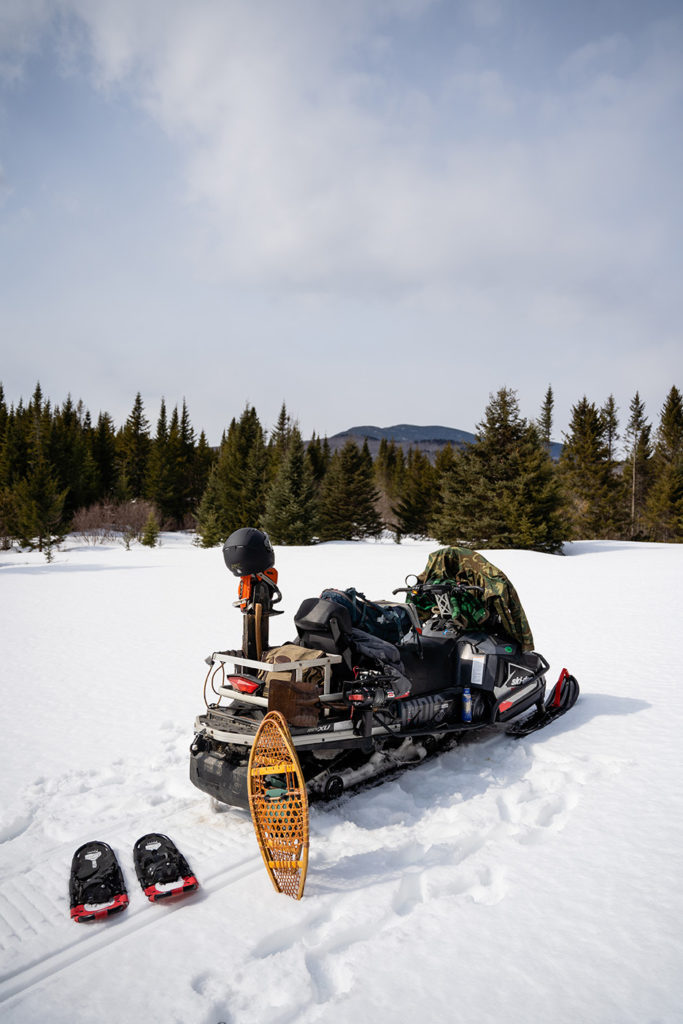Bridging Community and Conservation in the Acadian Forest
How AMC’s Steve Tatko aims to preserve Maine’s forest ecosystem for future generations to enjoy.

Bridging Community and Conservation in the Acadian Forest
How AMC’s Steve Tatko aims to preserve Maine’s forest ecosystem for future generations to enjoy.
by Jenny O’Connell
Photography by Andy Gagne
Issue: November // December 2022
I have always had this sense that our relationship to the forest needs to be better understood, better explored, so we develop a sense of stewardship and connection to these places,” says Steve Tatko, senior director of Maine conservation and land management at the Appalachian Mountain Club, “so people will invest themselves in keeping them whole.”
This, in a sentence, is Tatko’s life’s work.
Founded in 1876 by U.S. astronomer and physicist Edward Charles Pickering, the Appalachian Mountain Club (AMC) is North America’s oldest conservation group. Dedicated to the protection, enjoyment, and understanding of the outdoors, the organization maintains 1,800 miles of trails from Maine to Washington, D.C. It supports conservation research, advocacy for the protection of lands and waters, a science-based approach to climate change resilience, and initiatives aimed at making nature accessible to everyone. “Our lens has always been using outdoor recreation and education as a tool to develop relationships with places,” Tatko says. In Maine the AMC owns 75,000 acres of forestland—soon to be 100,000—in the heart of the 100 Mile Wilderness. It also operates three full-service lodges connected by more than 90 miles of trails, which provide public access to fly-fishing, paddling, skiing, and hiking, among other recreational activities. Tatko oversees everything from forest management and timber harvests to road construction and from trail infrastructure to watershed restoration, fundraising, and relationship-building with community stakeholders. “If it happens on the land, I’m either out there with the tools doing it or working with the contractors who are doing the work,” he says.


Tatko is the definition of an old soul. Sure, he may be 35, but he grew up in Willimantic, a small town 14 miles as the crow flies from the 100 Mile Wilderness, listening to the stories of his elders—stories about logging and river driving and even the first electric lightbulb in town. He wears leather boots and wooden snowshoes and cooks over the campfire in a cast-iron pan when he’s working in the field. As a history major at Colby College, Tatko studied the socioeconomic history of the Northeast, which, combined with knowledge of geology and indigenous history, informs his complex and layered understanding of the land he’s working to protect. This core-deep understanding of what Maine was—and what it is becoming—makes him an important bridge connecting local communities to the AMC’s conservation efforts. Whether it’s problem solving with rural communities whose identities have been built around traditional timber harvesting or collaborating with Wabanaki tribes on river restoration and other conservation projects, Tatko believes that listening to community voices is essential to getting any real work done. “The Wabanaki have 12,000 years of forest management, and so that’s a central voice to these restoration efforts,” he says. “You’re talking about people who have experience with this place before it was a forest. They literally watched the forest grow up out of nowhere.”
Maine’s AMC takes a two-pronged approach to conservation, balancing responsible timber harvesting with land conservation, recreational opportunities, and community economic development. Since the organization purchased 37,000 acres of forest at the southern end of the 100 Mile Wilderness from International Paper in 2003, they have been working to develop a new model of landownership for the Northeast. Some wonder why a nonprofit dedicated to protecting Maine mountains, forests, and waters would be in the business of cutting down trees. Wood products have been a staple of Maine’s economy for the past 200 years and remain a main source of income for many communities, including those around the AMC’s Maine Woods property. Together with Huber Resources Corporation, a forestry consulting business based in Old Town, Tatko is working to replace the traditional industrial model of forestry, which often focuses solely on wood production at the expense of ecosystems and communities, with responsible forestry, which balances both.
“I don’t think people in Maine realize that our little Acadian forest variant is very rare,” he says. The last intact piece of a larger forest biome that used to extend like a band around this latitude through Europe, Japan, China, and Korea, the Maine woods are a transition zone between the boreal forest to the north and the northern hardwoods and southern Appalachian hardwoods to the south. For 7,000 years this land has been nothing but a forest, which means that habitat connectivity and natural resilience is still present. “This is one of the few places in the world where you can work with natural systems to address climate change,” says Tatko. “That’s what sets Maine apart.”

In AMC’s responsible forestry process—known as late-successional management—trees are cut selectively with the intention of replicating the same diffuse light of the forest that allows for a natural ecosystem to flourish, maintaining ecological diversity and promoting natural regeneration. Old trees are left to grow big and die naturally, increasing the forest’s ability to sequester carbon. Special attention is given to conserving vulnerable habitats and species, minimizing erosion from roads, protecting rivers and streams, and incorporating community concerns into management strategy. Income from forestry efforts and recreation infrastructure such as the AMC lodges supports programming and helps offset the costs of land ownership. Additionally, Tatko is concerned with encouraging the growth of climate-resilient species like sugar maple, yellow birch, and red spruce. “There’s a recognition that red spruce, in a couple lifetimes, might be gone from this forest,” he says. “White pine and oak will transition farther north as the climate warms. But there’s still value in promoting these species. The advance of climate will take time, and we don’t know what the forest will look like without them.”
In the face of a changing world, Tatko sees his role as preserving as much of the forest ecosystem as he can for future generations to enjoy. “There’s a wake-up call for all of us,” he says. “People are starting to realize that the actors have already changed on the stage. But if the stage isn’t here, the play can’t go on at all.” He envisions a future where wood products play an even more central role, one day replacing oil-based synthetics. “We’ve known since World War II that you can make almost anything out of wood that you can make out of plastics,” he says. “That’s a much better climate outcome than continuing to rely on fossil fuels for our clothing, for our insulation, and for our throwaway goods. If we’re going to go wholeheartedly into taking into consideration our material culture and where it comes from, then we need to start thinking about what we do take from the forest, and how to utilize it more efficiently.”

Maine’s AMC takes a two-pronged approach to conservation in the 100 Mile Wilderness area, balancing responsible timber harvesting with land conservation, recreational opportunities, and community economic development.

The critical point of AMC’s work is to help people understand why the forest is a resource worth protecting—something Tatko, who grew up nearby, has always understood. He knows every tree by name. When they’re cut, he counts their rings. Walk with him into the woods for an afternoon, and you’ll leave knowing the local history; you’ll start to feel the passion he has for the place he’s always called home. “It was inherent in how people talked to me about the forest, and how people taught me about how it works, that it’s a fragile thing,” he says. “And whether we explicitly state it or not, we have dominion over it. People have converted forest to other uses for generations. I’m just constantly reminded that that sense of dominion over a place creates a barrier, as do constructs around wilderness. Forests shouldn’t be put in a glass box. People’s ability to experience those places is central to their ability to function.”
The AMC encourages adventurers of all ages, abilities, and backgrounds to engage and connect: volunteer for a trail workday or lead a local outing; stay at an AMC campsite, cabin, lean-to, or lodge; paddle one of the wild lakes or fly-fish a running stream. And when you’re out there, take a look at the trees. Late-succession forestry takes nearly a century to reach effect, and Tatko won’t live to see the fruit of his efforts. “This is a really long-term restoration project that I’ll spend my working career on, but it’ll be my successors that will actually see the results,” he says. Yet, he understands his place in history, and how the actions we take today lay the foundation for future generations to have access to the forest and all it provides. “Everybody loves the forest, but I think we don’t realize just how amazingly unique Maine’s forests actually are,” Tatko says. “No one else has this. It’s here. This is our gift to the world.”
Read More:
- Branching Out

- 48 Hours in Cape Elizabeth, South Portland + Scarborough

- 4 Unique Winter Weekends

- Where to Cross-Country Ski This Winter

- Brunswick in 48 Hours


